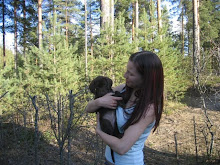
Fear is dog´s normal self-protective response to potentially injurious stimulation, it´s natural. It is expressed in three broad ways: freeze, flight and fight. Fear-elicited fighting occurs in situations involving intense fearful arousal and where flight is blocked. Outward signs of fear include a variety of body postures, facial expressions and physiological indicators. Dogs will freeze, attempt to escape or attack, depending on the fear-eliciting situation. Physiological changes in dog are among other things raised pulse, increased panting, thick salivatio, raised blood pressure, shivering and trembing, pupillary dilation, and lose bowel and bladder control. A fearful dog will often lower its head and avert eye contact, fasten its ears back and tuck the tail tightly between the legs. Fearful dogs may also scramble frantically to escape or evade a feared object while loudly whining, yelping or shrieking.
When a dog is frightened, for example sudden loud noise, it reacts instinctively. So fear is an adaptive emotional response to threats and danger. It is a basic survival mechanism. In brain fear is processed by thalamus. There are two routes, auditory cerebral cortex (slow route, processes the information and gives directives) and amygdala (fast route, subliminal). After the information has moved on, nucleus either stimulates or turns off the autonomic nervous system. Fear has its "own" region of the brain and severe fright develops a memory of the stimulus and also memory of the action and its efectiviness.
Phylogenic sources of fear include such triggers as pain, rapid stimulus change, sudden movements, heights, isolation, loud noises, strangers, fire, water, and unfamiliar enviromental and social situtations. Whereas ontogenic sources of fear are mostly the result of learning and experience. Pathogenic fear (generalized anxiety and phobia) occurs when the fearful arousal cannot be avoided or escaped. Dogs that are pathologically anxious or phobic, are unable adaptively to escape or avoid fearful arousal. So these dogs labor futilely under the influence of escalating fear and anxiety.
Systematic desensitization (classical conditioning) is a safe way to treat fear related problems. It refers to a careful manipulation of the intensity of the fear-evoking thing, so that it doesn´t generate a fear response. Desensitization requires patience and careful planning from the dog trainer. Counterconditioning (classical conditioning) is ussually used together with desensitization. It essentially involves opposing one response by the elicitation of another. To be controlled, fear must be countered by the elicitation of an even stronger and incompatible emotional response. So right after much less frightening stimulus is presented to the dog, a pleasant thing - the conterconditioning stimulus - is presented, to build a new association. This may be a favorite toy, game or tasty food, but it must be extremely potent. Systematic desensitization and counterconditioning requires a great deal of repetitions, and only after that we can start to build substitutive action to replace the fear reaction. The final goal is that the stimulus (that triggered fear) becomes a clue to do something (for example "sit", "look" etc.) that is incompatible for fear (operant conditioning).
It is important to check dog´s heath (exercise, nutrition, activivation etc.) first and sort out fear-eliciting situations and events. We must carefully identify the stimuli that evoke fear and the situations in which fearful behavior is likely to occur. For example, counterconditioning can be carried out to a wrong stimulus, if we don´t know exactly what triggers the fear in dog. Animal behaviorism also knows a method called flooding in reducing fear. Flooding is a desensitization process with direct exposure to the fear-evoking stimulus until fear subsides. A precaution needs to be carefully observed: if dog is fearful when the flooding exposure is terminated, its fearfulness might be made worse. Flooding is a problematic method because it is hard to accomplish in practice, it involves risks and it evokes stress in dog.
We can use operant conditioning also (with classical conditioning) in fear-evoking situations. In that case we reinforce dog´s calm state of mind by withdrawing the fear-evoking stimulus (negative reinforcement). So dog learns to regulate the frightening situation with its own behavior. This technique is problematic because we have to know exactly what is/are the fear-evoking stimulus and remove it/them just the right time.
Dog´s owner has also a very important role when reducing fear in the dog. Dog´s social dependency (social learning) makes it keenly aware of the behavior of others (also owner´s behavior). So its good to remember it as a assistance when redusing fear in dogs. Medication can also be one cure and assistance to fear problems.


No comments:
Post a Comment